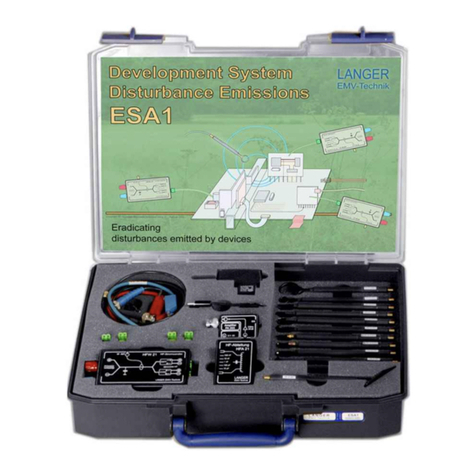1Description of the E1 immunity development system
The E1 immunity development system is an advanced tool for the electronics developer to examine the
immunity of modules to pulsed interference (burst/ESD) in experiments. The system allows him to analyse
the interference immunity in the confined space of a module. The selective injection of disturbance current
into individual sections (disturbance current paths) and application of pulsed electric (E fields) or magnetic
(H fields) fields to selected areas of the module's surface are decisive for the localisation of weak points.
While pulsed disturbances are applied to the device under test, the signals can be monitored
simultaneously via optical fibre without interaction.
The E1 immunity development system has been specially designed for the development process. It helps
the developer suppress interference in devices/modules or further harden them since it allows him to
clarify the immediate causes of immunity problems and test the effects of counter-measures directly.
The E1 immunity development system cannot be used for standard compliance tests. Testing a module's
immunity on the basis of the IEC 61000-4-4 and IEC 61000-4-2 standards, however, is an ideal starting point
for examining the device under test with the E1. The disturbances generated by the standard burst
generator in accordance with the standard are injected into the supply lines of the device under test and
flow back to the generator via ground. The paths on which the pulse-shaped disturbances flow through the
device module are not known. An unknown percentage of these disturbances encounters an unknown
victim in the device and generates a functional fault. This weak point can usually be pinpointed to a few
square centimetres of a module but can only be localised with difficulty in a standard compliance test. The
developer does not yet know if and where the disturbance current with its associated magnetic field
induces a voltage pulse in a conductor loop or couples electric field capacitively to sensitive lines.
Exact information about the fault pattern that has occurred is the decisive result of a failed compliance test.
But the fault pattern does not reveal precisely where the weak point of the device under test lies. A test in
accordance with the standard should thus initially be performed to determine the immunity of the device
under test so as to identify the fault pattern. The developer can then use the E1 at his workplace to analyse
the causes of the immunity problems, where the functional faults shown in the fault pattern provide a
certain orientation for interference suppression.
The immunity development system allows the developer to verify the effectiveness of EMC modifications
carried out in the interference suppression process immediately and thus to achieve a significant reduction
in the development time and development costs.



























